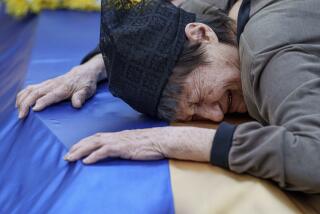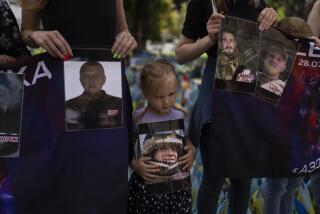NATO May Have Hit Civilians in Convoy, General Says
- Share via
BRUSSELS — A U.S. Air Force general acknowledged Monday that NATO planes may have bombed civilian vehicles and taken civilian lives in attacks on two convoys in Kosovo last week.
But Brig. Gen. Dan Leaf spelled out a variety of other possibilities, all of them holding the Serbs who control Yugoslavia responsible for any civilian deaths--for causing the refugee flow to begin with--and suggesting that the Serbs might have rigged the scene of the carnage before allowing Western reporters to see it.
“This is a very complicated scenario,” Leaf said, “and we will never be able to determine all the exact details.”
But a Times reporter, unescorted by authorities, was on the scene of one of the bombings less than 90 minutes after the attack and saw no indications of tampered evidence, and no refugees told him of the presence of Serbian military vehicles in their convoy, as claimed by NATO officials last week and Monday.
What happened Wednesday is crucial in the public relations campaign over Kosovo. Yugoslav charges that NATO bombs killed dozens of civilians have threatened to knock the moral high ground from beneath NATO, whose air war is aimed at stopping Yugoslav President Slobodan Milosevic’s campaign of “ethnic cleansing” of Kosovo Albanians.
NATO only made its own position appear worse last week when it offered partial explanations that raised more questions than they answered. The allies apparently hope that Monday’s account will lay the matter to rest.
Leaf, commander of the 31st Air Expeditionary Wing at Aviano Air Base in Italy, gave an account of two airstrikes in southwestern Kosovo on Wednesday afternoon. During a period of an hour and 50 minutes, he said, NATO aircraft dropped nine 500-pound laser-guided bombs on what its pilots believed to be Serbian military vehicles.
The first, smaller incident was the same one that an American F-16 pilot described in an audiotape played at NATO headquarters Thursday. The pilot said he targeted the lead vehicle in a group of three vehicles whose occupants appeared to be going house to house along a dirt road, setting fire to each in turn.
When the bomb struck its target, the F-16 pilot, running low on fuel, turned back and passed authority for the scene to another F-16 pilot. The second pilot dropped a second bomb on one of several vehicles inside the courtyard of a housing complex. That bomb not only hit its target but also triggered an explosion inside the housing complex--probably the result of gasoline that the Serbs reportedly hide inside homes and use to refuel their vehicles or burn houses. If there were any civilian casualties at the housing complex, Leaf suggested, this explosion may well have been responsible.
Shortly afterward, NATO planes came upon a convoy of more than 100 vehicles that stretched several miles along a paved highway only a few miles away. The 20 vehicles in front looked alike and maintained constant spacing despite their high speed--”characteristics of military movement,” Leaf said.
Even if the vehicles were built for civilian purposes, Leaf added, “there have been reports of Serb forces using civilian vehicles for military and paramilitary operations.”
In any event, the NATO command-and-control plane on the scene, which Leaf said had access to information from both operational and intelligence sources, reported that the convoy was military. “Great,” said the F-16 pilot who had been first to spot the convoy. “I want as many fighters as I can get, now.”
Altogether, eight NATO planes converged on the scene and dropped seven bombs in all. Only three of them appeared to have hit targets.
At that point, intelligence specialists at the air base in Italy radioed to the aircraft over Kosovo that Serbian forces do not usually travel in such large convoys. A low-flying OA-10 aircraft, slower and more stable than the F-16s and therefore a better observation platform than the F-16s, was summoned.
“The OA-10 forward air controller carefully analyzed the convoy through his binoculars and stated that there were definitely military vehicles in there but that multicolored and possibly civilian vehicles were also present,” Leaf said.
The F-16 controlling the operation thereupon halted the attack and ordered all NATO planes out of the area.
A day later, Yugoslav officials brought Western reporters from Belgrade, the Serbian and Yugoslav capital, to witness what they said was the result of a NATO attack on civilian vehicles on the highway.
“The 24-hour delay in showing the large convoy to the press would have allowed sufficient time for Serb forces to remove any military vehicles or personnel from the area,” Leaf said, “and we simply cannot verify exactly what type of vehicles were struck by whom.”
However, he said, there were some suspicious circumstances. Some of the Western reporters said the victims whose bodies they saw appeared to have been machine-gunned, not bombed. But the Times reporter who visited the scene of the bombings, both on the day of the attacks and a day later, said the wounds appeared to be consistent with bombings.
The Times reporter also saw remnants of bombs that left much smaller craters than those expected of a 500-pound bomb at several locations along the road--and some remnants had the letters ALCOA on them, suggesting they had been made by the American aluminum company.
Leaf said Monday that refugees who had been on the same road on the same afternoon reported being strafed by “low-flying MIG-type aircraft expending cluster munitions, and they also reported grenades thrown from helicopters. In this incident, NATO aircraft did not fly at low altitude, expended no cluster munitions and did not include helicopters.”
And other witnesses said they saw a Serbian mortar attack on a column of refugees even as the NATO attack was proceeding.
“The witnesses believed that the Serbs used the convoy as a human shield, positioning some of their military vehicles and police vehicles at the front of the column,” Leaf said. “In essence, this report claimed that after NATO attacked the front military vehicles, Serb aircraft attacked the Kosovar Albanian refugees in the rear.”
Leaf declined to say whether NATO had changed its attack procedures as a result of the incidents.
More to Read
Sign up for Essential California
The most important California stories and recommendations in your inbox every morning.
You may occasionally receive promotional content from the Los Angeles Times.













